Change Management: Duckett Report Analysis and NSQHS Standards Review
VerifiedAdded on 2020/03/23
|28
|8071
|253
Report
AI Summary
This report analyzes the Duckett Report (2016), commissioned in response to concerns about clinical governance and patient safety within Victorian hospitals. The report identifies significant deficiencies, including isolation in governance, complications in healthcare leading to preventable patient harm, lack of transparency, issues with data sharing and flow of information, cultural issues, and instances of independent clinical expertise failures. The analysis connects these deficiencies to the National Safety and Quality Health Service Standards (NSQHS) 2012, demonstrating how improvements are needed across multiple standards to enhance patient safety and quality of care. The report emphasizes the need for change management strategies to address these issues and improve the overall healthcare system in Victoria. The report discusses the implications of these deficiencies and their relationship to the NSQHS standards, highlighting the need for improved governance, patient-centered care, infection control, medication safety, patient identification, clinical handover, blood product management, pressure injury prevention, clinical deterioration response, and fall prevention. The report underscores the importance of transparency, data-driven decision-making, and a supportive workplace culture to address these challenges effectively.
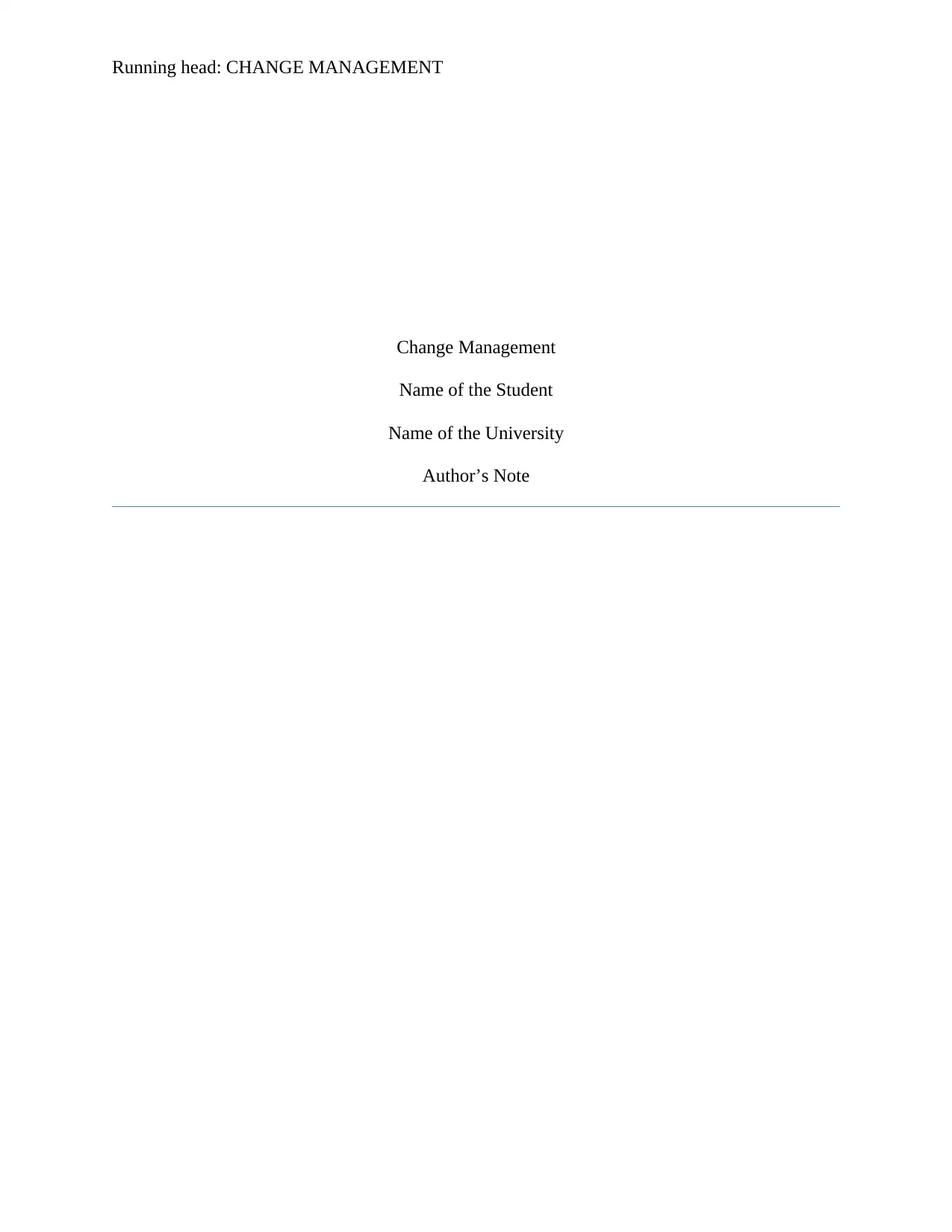
Running head: CHANGE MANAGEMENT
Change Management
Name of the Student
Name of the University
Author’s Note
Change Management
Name of the Student
Name of the University
Author’s Note
Paraphrase This Document
Need a fresh take? Get an instant paraphrase of this document with our AI Paraphraser
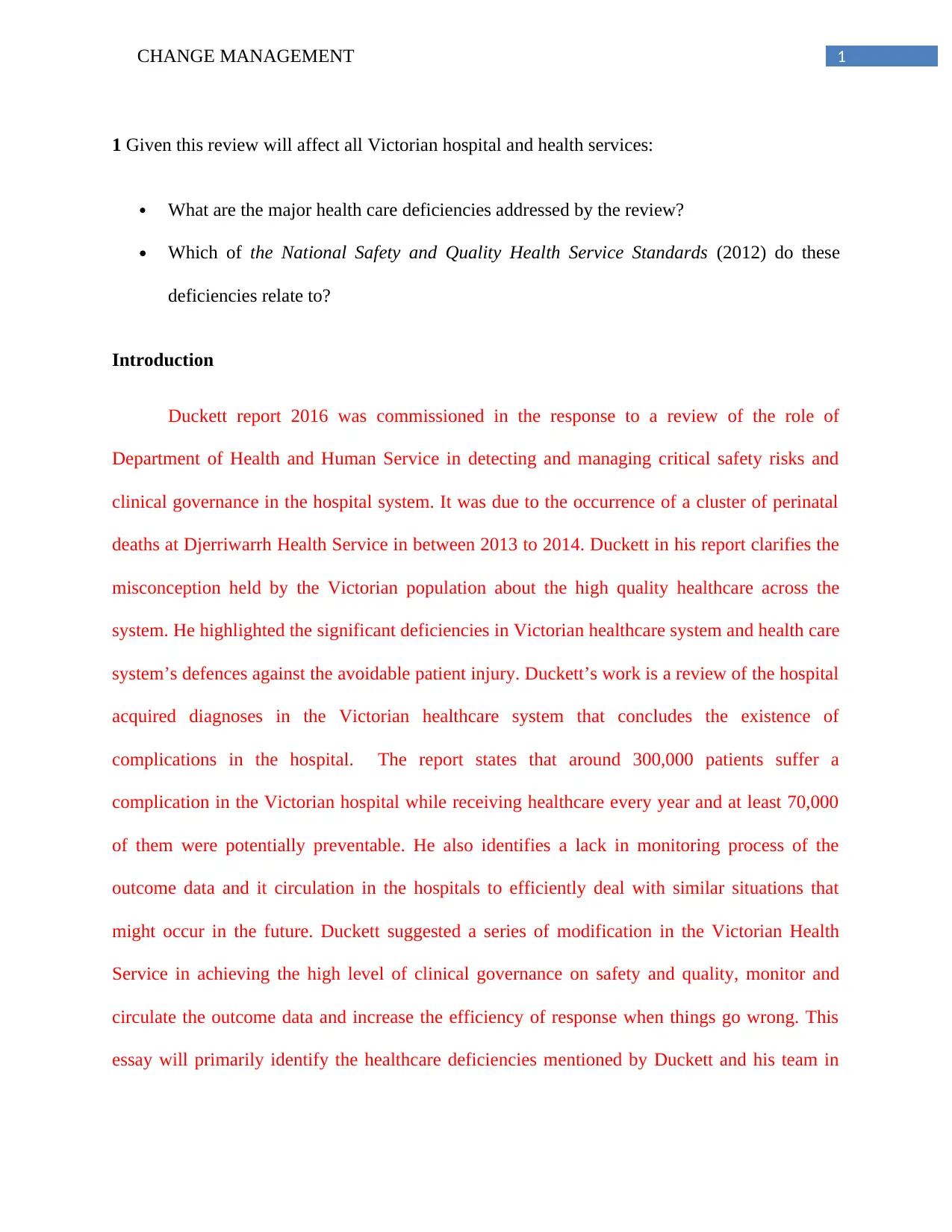
1CHANGE MANAGEMENT
1 Given this review will affect all Victorian hospital and health services:
What are the major health care deficiencies addressed by the review?
Which of the National Safety and Quality Health Service Standards (2012) do these
deficiencies relate to?
Introduction
Duckett report 2016 was commissioned in the response to a review of the role of
Department of Health and Human Service in detecting and managing critical safety risks and
clinical governance in the hospital system. It was due to the occurrence of a cluster of perinatal
deaths at Djerriwarrh Health Service in between 2013 to 2014. Duckett in his report clarifies the
misconception held by the Victorian population about the high quality healthcare across the
system. He highlighted the significant deficiencies in Victorian healthcare system and health care
system’s defences against the avoidable patient injury. Duckett’s work is a review of the hospital
acquired diagnoses in the Victorian healthcare system that concludes the existence of
complications in the hospital. The report states that around 300,000 patients suffer a
complication in the Victorian hospital while receiving healthcare every year and at least 70,000
of them were potentially preventable. He also identifies a lack in monitoring process of the
outcome data and it circulation in the hospitals to efficiently deal with similar situations that
might occur in the future. Duckett suggested a series of modification in the Victorian Health
Service in achieving the high level of clinical governance on safety and quality, monitor and
circulate the outcome data and increase the efficiency of response when things go wrong. This
essay will primarily identify the healthcare deficiencies mentioned by Duckett and his team in
1 Given this review will affect all Victorian hospital and health services:
What are the major health care deficiencies addressed by the review?
Which of the National Safety and Quality Health Service Standards (2012) do these
deficiencies relate to?
Introduction
Duckett report 2016 was commissioned in the response to a review of the role of
Department of Health and Human Service in detecting and managing critical safety risks and
clinical governance in the hospital system. It was due to the occurrence of a cluster of perinatal
deaths at Djerriwarrh Health Service in between 2013 to 2014. Duckett in his report clarifies the
misconception held by the Victorian population about the high quality healthcare across the
system. He highlighted the significant deficiencies in Victorian healthcare system and health care
system’s defences against the avoidable patient injury. Duckett’s work is a review of the hospital
acquired diagnoses in the Victorian healthcare system that concludes the existence of
complications in the hospital. The report states that around 300,000 patients suffer a
complication in the Victorian hospital while receiving healthcare every year and at least 70,000
of them were potentially preventable. He also identifies a lack in monitoring process of the
outcome data and it circulation in the hospitals to efficiently deal with similar situations that
might occur in the future. Duckett suggested a series of modification in the Victorian Health
Service in achieving the high level of clinical governance on safety and quality, monitor and
circulate the outcome data and increase the efficiency of response when things go wrong. This
essay will primarily identify the healthcare deficiencies mentioned by Duckett and his team in

2CHANGE MANAGEMENT
the review and relate them with the standards of National Safety and Quality Health Service
2012.
Major Health care Deficiencies Identified in the Duckett’s Review
Duckett and his team have identified several issues that need attention to eradicate the
health care deficiencies prevailing among the Victorian hospitals. The review addresses some of
the major deficiencies that are discussed in the following.
Isolation in Governance
Many of the hospitals in Victoria achieved success in innovation, accountabilities to local
communities and even reflect exceptional leadership. However, these successes are limited to the
particular hospital. Duckett’s (2016) report identifies the principle of devolution and local
autonomy among for justifying the inadequacy and inefficiency of the healthcare system in
disseminating the innovations achieved by individual hospitals. Implementation of strategies,
incentives and cultural development are the keys to achieve the standard quality and safety as
identified by Bismark, Walter and Studdert in their work in 2013. Duckett’s report (2016) finds
significant gap in the legislative requirements for big and small and the private hospitals. This
contributes to the variation in adequate skills in both financial and legal sector (Bismark &
Studdert, 2014). Lack of proper justification leads the community to formulate the idea that these
deficiencies are the medical issues that are resulting into the low quality of health service and
safety. Implementation of strategies and specifying the roles and responsibilities of the board can
help the hospitals increasing the quality.
Complication of Health Care
the review and relate them with the standards of National Safety and Quality Health Service
2012.
Major Health care Deficiencies Identified in the Duckett’s Review
Duckett and his team have identified several issues that need attention to eradicate the
health care deficiencies prevailing among the Victorian hospitals. The review addresses some of
the major deficiencies that are discussed in the following.
Isolation in Governance
Many of the hospitals in Victoria achieved success in innovation, accountabilities to local
communities and even reflect exceptional leadership. However, these successes are limited to the
particular hospital. Duckett’s (2016) report identifies the principle of devolution and local
autonomy among for justifying the inadequacy and inefficiency of the healthcare system in
disseminating the innovations achieved by individual hospitals. Implementation of strategies,
incentives and cultural development are the keys to achieve the standard quality and safety as
identified by Bismark, Walter and Studdert in their work in 2013. Duckett’s report (2016) finds
significant gap in the legislative requirements for big and small and the private hospitals. This
contributes to the variation in adequate skills in both financial and legal sector (Bismark &
Studdert, 2014). Lack of proper justification leads the community to formulate the idea that these
deficiencies are the medical issues that are resulting into the low quality of health service and
safety. Implementation of strategies and specifying the roles and responsibilities of the board can
help the hospitals increasing the quality.
Complication of Health Care
⊘ This is a preview!⊘
Do you want full access?
Subscribe today to unlock all pages.

Trusted by 1+ million students worldwide
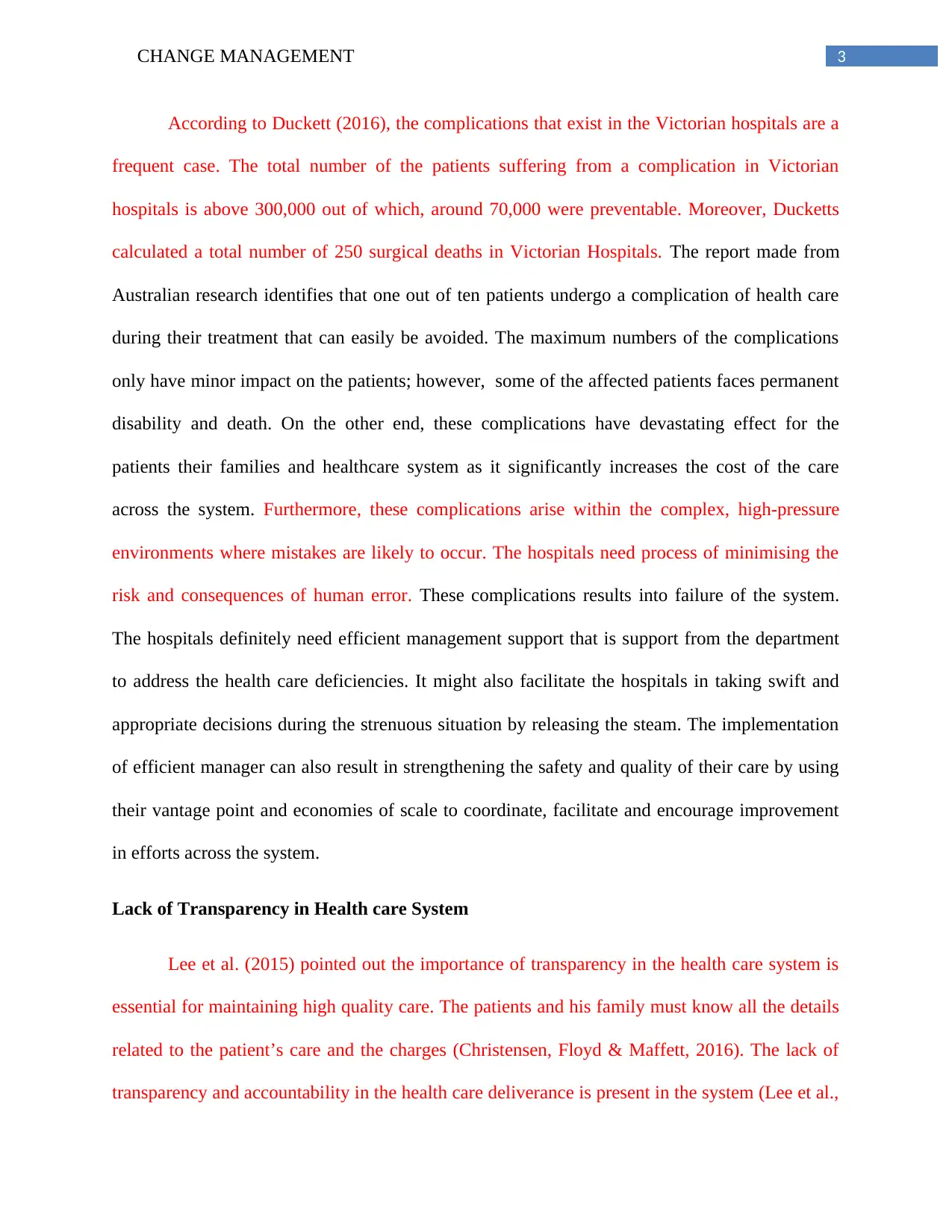
3CHANGE MANAGEMENT
According to Duckett (2016), the complications that exist in the Victorian hospitals are a
frequent case. The total number of the patients suffering from a complication in Victorian
hospitals is above 300,000 out of which, around 70,000 were preventable. Moreover, Ducketts
calculated a total number of 250 surgical deaths in Victorian Hospitals. The report made from
Australian research identifies that one out of ten patients undergo a complication of health care
during their treatment that can easily be avoided. The maximum numbers of the complications
only have minor impact on the patients; however, some of the affected patients faces permanent
disability and death. On the other end, these complications have devastating effect for the
patients their families and healthcare system as it significantly increases the cost of the care
across the system. Furthermore, these complications arise within the complex, high-pressure
environments where mistakes are likely to occur. The hospitals need process of minimising the
risk and consequences of human error. These complications results into failure of the system.
The hospitals definitely need efficient management support that is support from the department
to address the health care deficiencies. It might also facilitate the hospitals in taking swift and
appropriate decisions during the strenuous situation by releasing the steam. The implementation
of efficient manager can also result in strengthening the safety and quality of their care by using
their vantage point and economies of scale to coordinate, facilitate and encourage improvement
in efforts across the system.
Lack of Transparency in Health care System
Lee et al. (2015) pointed out the importance of transparency in the health care system is
essential for maintaining high quality care. The patients and his family must know all the details
related to the patient’s care and the charges (Christensen, Floyd & Maffett, 2016). The lack of
transparency and accountability in the health care deliverance is present in the system (Lee et al.,
According to Duckett (2016), the complications that exist in the Victorian hospitals are a
frequent case. The total number of the patients suffering from a complication in Victorian
hospitals is above 300,000 out of which, around 70,000 were preventable. Moreover, Ducketts
calculated a total number of 250 surgical deaths in Victorian Hospitals. The report made from
Australian research identifies that one out of ten patients undergo a complication of health care
during their treatment that can easily be avoided. The maximum numbers of the complications
only have minor impact on the patients; however, some of the affected patients faces permanent
disability and death. On the other end, these complications have devastating effect for the
patients their families and healthcare system as it significantly increases the cost of the care
across the system. Furthermore, these complications arise within the complex, high-pressure
environments where mistakes are likely to occur. The hospitals need process of minimising the
risk and consequences of human error. These complications results into failure of the system.
The hospitals definitely need efficient management support that is support from the department
to address the health care deficiencies. It might also facilitate the hospitals in taking swift and
appropriate decisions during the strenuous situation by releasing the steam. The implementation
of efficient manager can also result in strengthening the safety and quality of their care by using
their vantage point and economies of scale to coordinate, facilitate and encourage improvement
in efforts across the system.
Lack of Transparency in Health care System
Lee et al. (2015) pointed out the importance of transparency in the health care system is
essential for maintaining high quality care. The patients and his family must know all the details
related to the patient’s care and the charges (Christensen, Floyd & Maffett, 2016). The lack of
transparency and accountability in the health care deliverance is present in the system (Lee et al.,
Paraphrase This Document
Need a fresh take? Get an instant paraphrase of this document with our AI Paraphraser
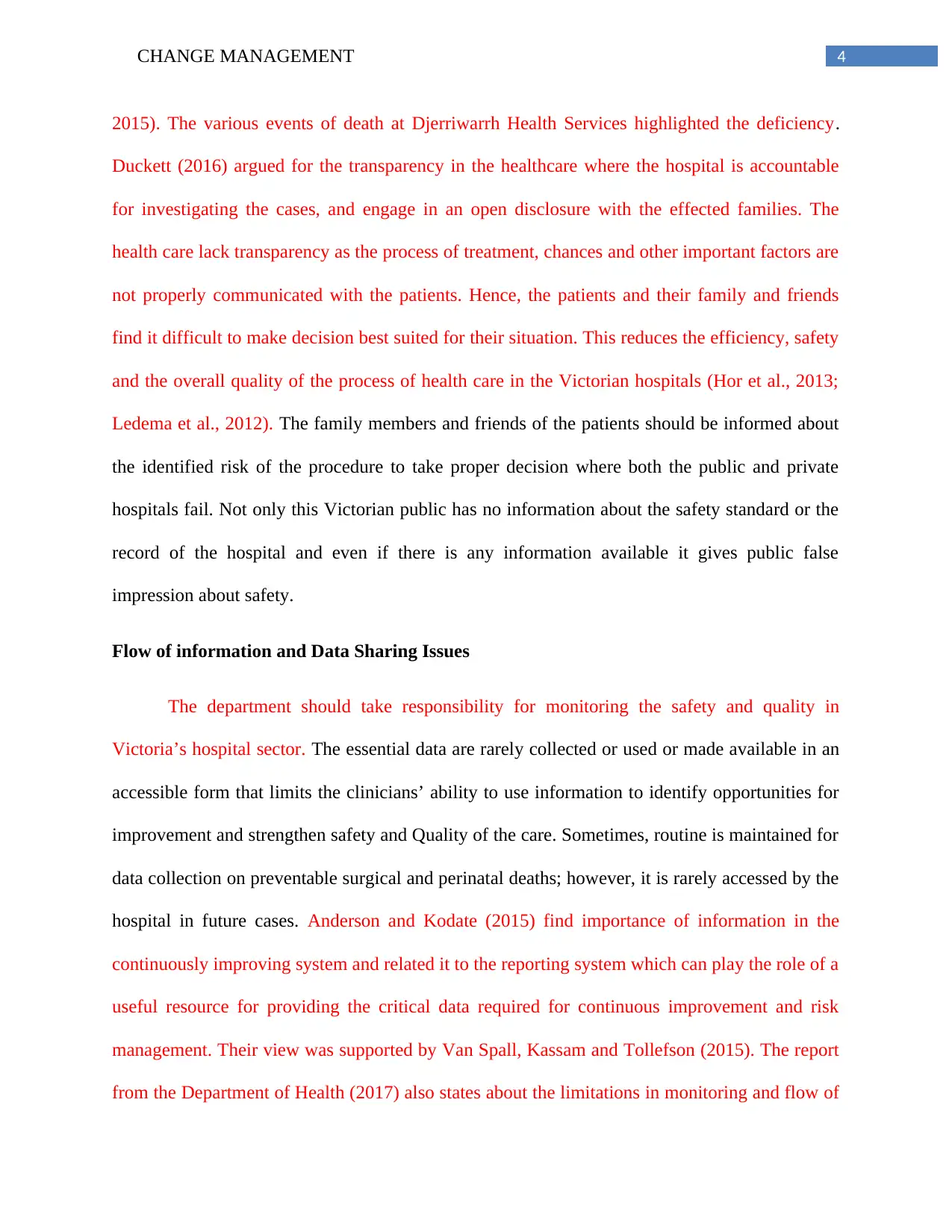
4CHANGE MANAGEMENT
2015). The various events of death at Djerriwarrh Health Services highlighted the deficiency.
Duckett (2016) argued for the transparency in the healthcare where the hospital is accountable
for investigating the cases, and engage in an open disclosure with the effected families. The
health care lack transparency as the process of treatment, chances and other important factors are
not properly communicated with the patients. Hence, the patients and their family and friends
find it difficult to make decision best suited for their situation. This reduces the efficiency, safety
and the overall quality of the process of health care in the Victorian hospitals (Hor et al., 2013;
Ledema et al., 2012). The family members and friends of the patients should be informed about
the identified risk of the procedure to take proper decision where both the public and private
hospitals fail. Not only this Victorian public has no information about the safety standard or the
record of the hospital and even if there is any information available it gives public false
impression about safety.
Flow of information and Data Sharing Issues
The department should take responsibility for monitoring the safety and quality in
Victoria’s hospital sector. The essential data are rarely collected or used or made available in an
accessible form that limits the clinicians’ ability to use information to identify opportunities for
improvement and strengthen safety and Quality of the care. Sometimes, routine is maintained for
data collection on preventable surgical and perinatal deaths; however, it is rarely accessed by the
hospital in future cases. Anderson and Kodate (2015) find importance of information in the
continuously improving system and related it to the reporting system which can play the role of a
useful resource for providing the critical data required for continuous improvement and risk
management. Their view was supported by Van Spall, Kassam and Tollefson (2015). The report
from the Department of Health (2017) also states about the limitations in monitoring and flow of
2015). The various events of death at Djerriwarrh Health Services highlighted the deficiency.
Duckett (2016) argued for the transparency in the healthcare where the hospital is accountable
for investigating the cases, and engage in an open disclosure with the effected families. The
health care lack transparency as the process of treatment, chances and other important factors are
not properly communicated with the patients. Hence, the patients and their family and friends
find it difficult to make decision best suited for their situation. This reduces the efficiency, safety
and the overall quality of the process of health care in the Victorian hospitals (Hor et al., 2013;
Ledema et al., 2012). The family members and friends of the patients should be informed about
the identified risk of the procedure to take proper decision where both the public and private
hospitals fail. Not only this Victorian public has no information about the safety standard or the
record of the hospital and even if there is any information available it gives public false
impression about safety.
Flow of information and Data Sharing Issues
The department should take responsibility for monitoring the safety and quality in
Victoria’s hospital sector. The essential data are rarely collected or used or made available in an
accessible form that limits the clinicians’ ability to use information to identify opportunities for
improvement and strengthen safety and Quality of the care. Sometimes, routine is maintained for
data collection on preventable surgical and perinatal deaths; however, it is rarely accessed by the
hospital in future cases. Anderson and Kodate (2015) find importance of information in the
continuously improving system and related it to the reporting system which can play the role of a
useful resource for providing the critical data required for continuous improvement and risk
management. Their view was supported by Van Spall, Kassam and Tollefson (2015). The report
from the Department of Health (2017) also states about the limitations in monitoring and flow of
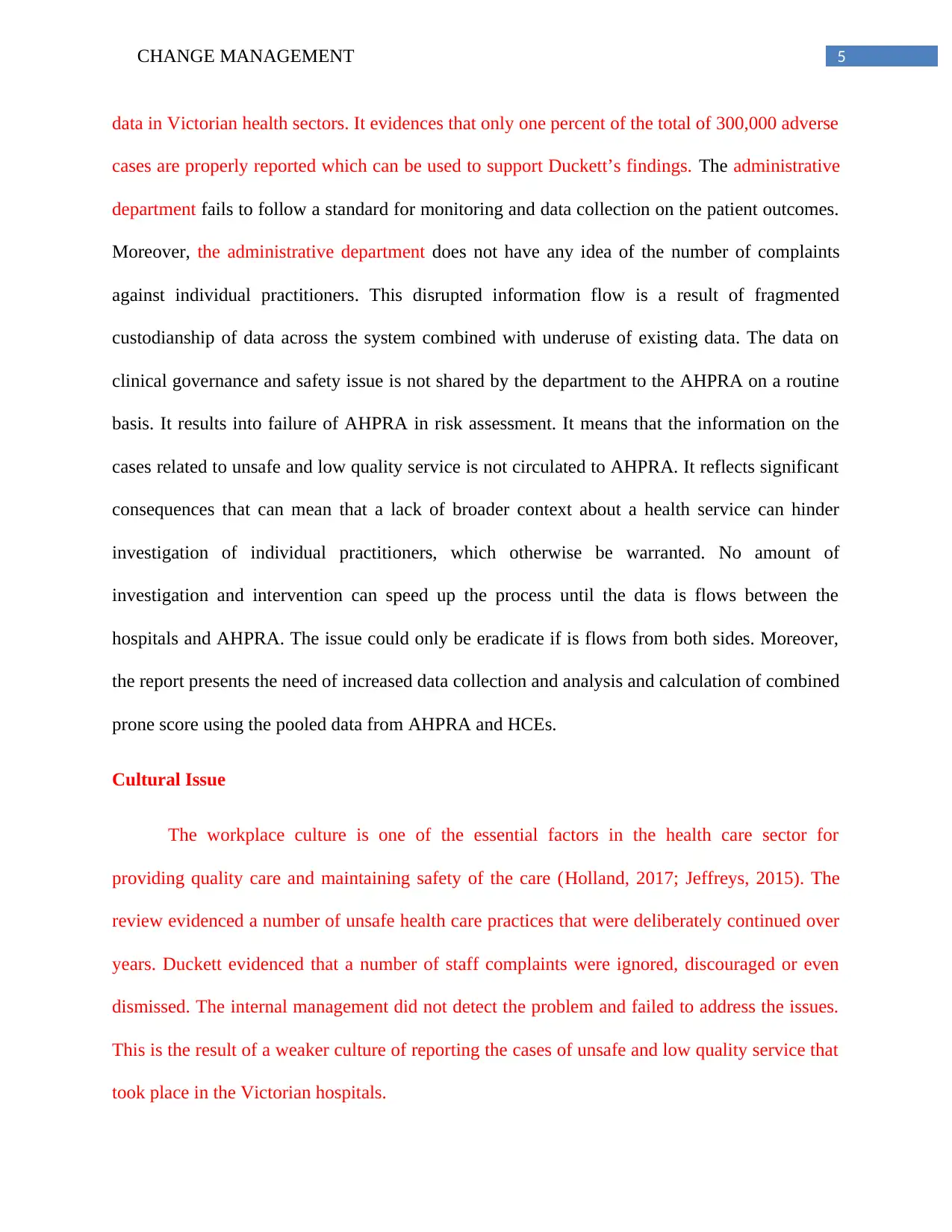
5CHANGE MANAGEMENT
data in Victorian health sectors. It evidences that only one percent of the total of 300,000 adverse
cases are properly reported which can be used to support Duckett’s findings. The administrative
department fails to follow a standard for monitoring and data collection on the patient outcomes.
Moreover, the administrative department does not have any idea of the number of complaints
against individual practitioners. This disrupted information flow is a result of fragmented
custodianship of data across the system combined with underuse of existing data. The data on
clinical governance and safety issue is not shared by the department to the AHPRA on a routine
basis. It results into failure of AHPRA in risk assessment. It means that the information on the
cases related to unsafe and low quality service is not circulated to AHPRA. It reflects significant
consequences that can mean that a lack of broader context about a health service can hinder
investigation of individual practitioners, which otherwise be warranted. No amount of
investigation and intervention can speed up the process until the data is flows between the
hospitals and AHPRA. The issue could only be eradicate if is flows from both sides. Moreover,
the report presents the need of increased data collection and analysis and calculation of combined
prone score using the pooled data from AHPRA and HCEs.
Cultural Issue
The workplace culture is one of the essential factors in the health care sector for
providing quality care and maintaining safety of the care (Holland, 2017; Jeffreys, 2015). The
review evidenced a number of unsafe health care practices that were deliberately continued over
years. Duckett evidenced that a number of staff complaints were ignored, discouraged or even
dismissed. The internal management did not detect the problem and failed to address the issues.
This is the result of a weaker culture of reporting the cases of unsafe and low quality service that
took place in the Victorian hospitals.
data in Victorian health sectors. It evidences that only one percent of the total of 300,000 adverse
cases are properly reported which can be used to support Duckett’s findings. The administrative
department fails to follow a standard for monitoring and data collection on the patient outcomes.
Moreover, the administrative department does not have any idea of the number of complaints
against individual practitioners. This disrupted information flow is a result of fragmented
custodianship of data across the system combined with underuse of existing data. The data on
clinical governance and safety issue is not shared by the department to the AHPRA on a routine
basis. It results into failure of AHPRA in risk assessment. It means that the information on the
cases related to unsafe and low quality service is not circulated to AHPRA. It reflects significant
consequences that can mean that a lack of broader context about a health service can hinder
investigation of individual practitioners, which otherwise be warranted. No amount of
investigation and intervention can speed up the process until the data is flows between the
hospitals and AHPRA. The issue could only be eradicate if is flows from both sides. Moreover,
the report presents the need of increased data collection and analysis and calculation of combined
prone score using the pooled data from AHPRA and HCEs.
Cultural Issue
The workplace culture is one of the essential factors in the health care sector for
providing quality care and maintaining safety of the care (Holland, 2017; Jeffreys, 2015). The
review evidenced a number of unsafe health care practices that were deliberately continued over
years. Duckett evidenced that a number of staff complaints were ignored, discouraged or even
dismissed. The internal management did not detect the problem and failed to address the issues.
This is the result of a weaker culture of reporting the cases of unsafe and low quality service that
took place in the Victorian hospitals.
⊘ This is a preview!⊘
Do you want full access?
Subscribe today to unlock all pages.

Trusted by 1+ million students worldwide

6CHANGE MANAGEMENT
Independent Clinical Expertise
The independent incompetence or malice is another complication faced by the healthcare
service of Victoria. A number of complex, high-pressure cases arrive where the patients are
already frail and at risk of deteriorating. The mistakes easily arise in these types of cases. The
hospitals require stronger process for minimising the risk and consequences of human error. The
administration also needs to ensure the process of monitoring, reporting, reviewing and
addressing these cases to ensure the avoidance of such incidents in the future time. This in turn
demands for a strong system manager who can protect the patients from serious failures in the
safety and quality. The role of the manager would be to oversee the quality and safety and ensure
to take swift and appropriate decisions to address the deficiencies (Buchbinder & Shanks, 2016).
Relating the issues with National Safety and Quality Health Service Standards (2012)
The Australian Commission on Safety and Quality in Health Care (ACSQHC) after
consulting with the technical experts, jurisdiction and a wide range of stakeholders including the
health professional and patients proposed ten National Safety and Quality Health Service
Standards for the hospitals. Maintaining these standards can potentially increase the safety and
quality of the health care service provided. The Standards are as follows:
Standard 1 – Governance for Safety and Quality in Health Service Organization that marks the
standard of the quality framework required for health service organizations to implement safe
system.
Standard 2 – Partnering with Customers that narrates the strategies and systems to create a
patient-centred health system by including patient in the development and design of quality
health care.
Independent Clinical Expertise
The independent incompetence or malice is another complication faced by the healthcare
service of Victoria. A number of complex, high-pressure cases arrive where the patients are
already frail and at risk of deteriorating. The mistakes easily arise in these types of cases. The
hospitals require stronger process for minimising the risk and consequences of human error. The
administration also needs to ensure the process of monitoring, reporting, reviewing and
addressing these cases to ensure the avoidance of such incidents in the future time. This in turn
demands for a strong system manager who can protect the patients from serious failures in the
safety and quality. The role of the manager would be to oversee the quality and safety and ensure
to take swift and appropriate decisions to address the deficiencies (Buchbinder & Shanks, 2016).
Relating the issues with National Safety and Quality Health Service Standards (2012)
The Australian Commission on Safety and Quality in Health Care (ACSQHC) after
consulting with the technical experts, jurisdiction and a wide range of stakeholders including the
health professional and patients proposed ten National Safety and Quality Health Service
Standards for the hospitals. Maintaining these standards can potentially increase the safety and
quality of the health care service provided. The Standards are as follows:
Standard 1 – Governance for Safety and Quality in Health Service Organization that marks the
standard of the quality framework required for health service organizations to implement safe
system.
Standard 2 – Partnering with Customers that narrates the strategies and systems to create a
patient-centred health system by including patient in the development and design of quality
health care.
Paraphrase This Document
Need a fresh take? Get an instant paraphrase of this document with our AI Paraphraser
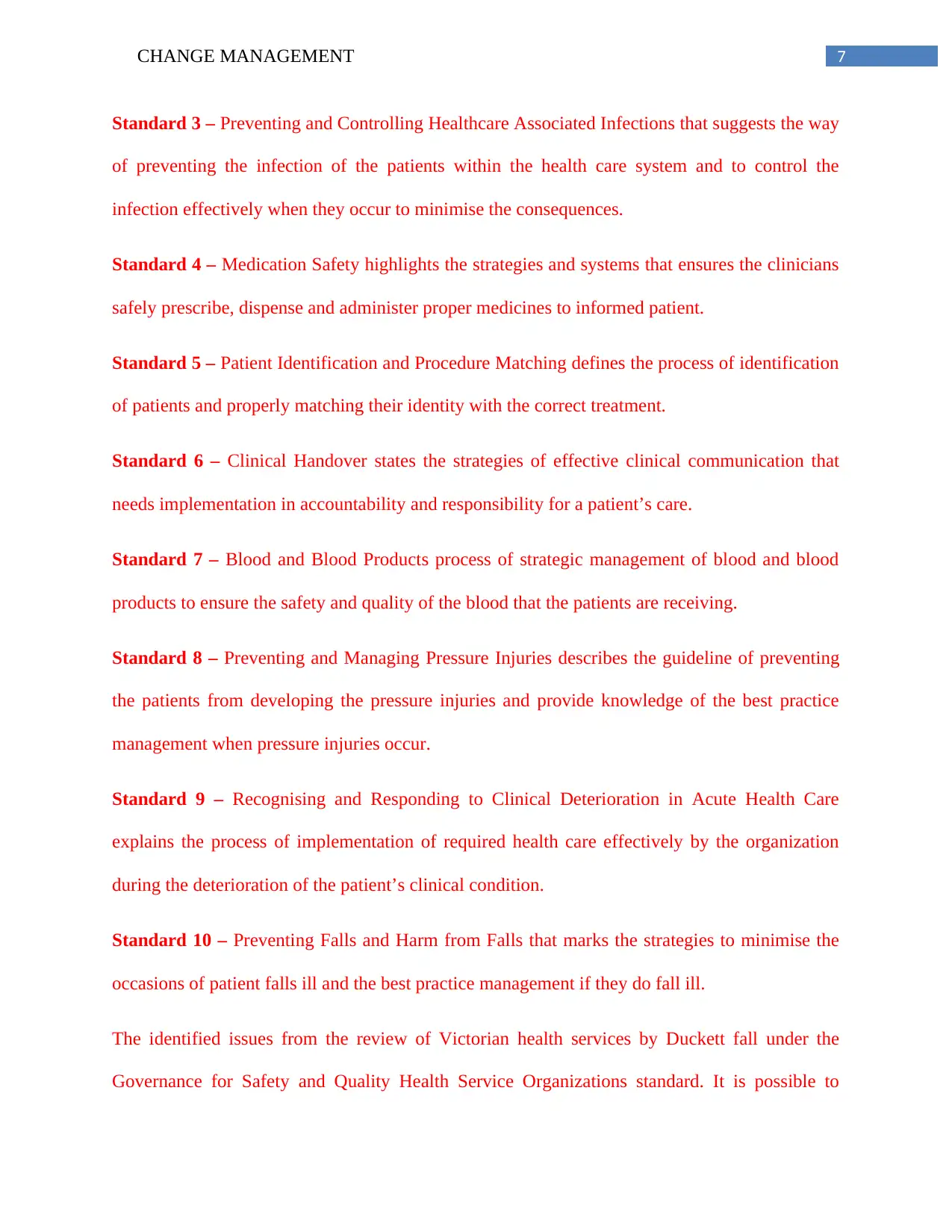
7CHANGE MANAGEMENT
Standard 3 – Preventing and Controlling Healthcare Associated Infections that suggests the way
of preventing the infection of the patients within the health care system and to control the
infection effectively when they occur to minimise the consequences.
Standard 4 – Medication Safety highlights the strategies and systems that ensures the clinicians
safely prescribe, dispense and administer proper medicines to informed patient.
Standard 5 – Patient Identification and Procedure Matching defines the process of identification
of patients and properly matching their identity with the correct treatment.
Standard 6 – Clinical Handover states the strategies of effective clinical communication that
needs implementation in accountability and responsibility for a patient’s care.
Standard 7 – Blood and Blood Products process of strategic management of blood and blood
products to ensure the safety and quality of the blood that the patients are receiving.
Standard 8 – Preventing and Managing Pressure Injuries describes the guideline of preventing
the patients from developing the pressure injuries and provide knowledge of the best practice
management when pressure injuries occur.
Standard 9 – Recognising and Responding to Clinical Deterioration in Acute Health Care
explains the process of implementation of required health care effectively by the organization
during the deterioration of the patient’s clinical condition.
Standard 10 – Preventing Falls and Harm from Falls that marks the strategies to minimise the
occasions of patient falls ill and the best practice management if they do fall ill.
The identified issues from the review of Victorian health services by Duckett fall under the
Governance for Safety and Quality Health Service Organizations standard. It is possible to
Standard 3 – Preventing and Controlling Healthcare Associated Infections that suggests the way
of preventing the infection of the patients within the health care system and to control the
infection effectively when they occur to minimise the consequences.
Standard 4 – Medication Safety highlights the strategies and systems that ensures the clinicians
safely prescribe, dispense and administer proper medicines to informed patient.
Standard 5 – Patient Identification and Procedure Matching defines the process of identification
of patients and properly matching their identity with the correct treatment.
Standard 6 – Clinical Handover states the strategies of effective clinical communication that
needs implementation in accountability and responsibility for a patient’s care.
Standard 7 – Blood and Blood Products process of strategic management of blood and blood
products to ensure the safety and quality of the blood that the patients are receiving.
Standard 8 – Preventing and Managing Pressure Injuries describes the guideline of preventing
the patients from developing the pressure injuries and provide knowledge of the best practice
management when pressure injuries occur.
Standard 9 – Recognising and Responding to Clinical Deterioration in Acute Health Care
explains the process of implementation of required health care effectively by the organization
during the deterioration of the patient’s clinical condition.
Standard 10 – Preventing Falls and Harm from Falls that marks the strategies to minimise the
occasions of patient falls ill and the best practice management if they do fall ill.
The identified issues from the review of Victorian health services by Duckett fall under the
Governance for Safety and Quality Health Service Organizations standard. It is possible to

8CHANGE MANAGEMENT
address the issues with this standard proposed by ACSQHC that describes the quality framework
required for health service organizations to implement safe system. However, the issues
identified require multilevel attention as they are related to each other. Hence, procedure
implemented for the complexity issue might also be useful in addressing the information flow
and service monitoring. On the other hand, a single issue might require assistance from a number
of actions proposed in the governance standard.
Clinical Governance
Bringing improvement in the clinical governance requires to setting a governance system
in the organization. The role of the system will be to set out policies procedures and protocols
achieving the standardized safety and quality. This seeks for a clinical governance framework,
identification of risks, collection and reviewing of performance data, implementation of
prevention strategies, and analysis of incidents. Following these suggestions will help the
organization to address the following issues that falls under clinical governance and increasing
the quality and safety of the service.
Complication of Health Care
This particular deficiency identified in the review needs attention in the managerial
ground and also the staff level training. The process of simplifying the complexity in the health
care service needs a proper management. Hence, implementation of an appropriate leader for the
task is necessary. A multiple level assistance required in resolving the issue.
Lack of Transparency in Health care System
The issue in the transparency in health care system identified from the report is possible
to address with the standard 2 in the NSQHSS that calls for a customer centred health system. It
address the issues with this standard proposed by ACSQHC that describes the quality framework
required for health service organizations to implement safe system. However, the issues
identified require multilevel attention as they are related to each other. Hence, procedure
implemented for the complexity issue might also be useful in addressing the information flow
and service monitoring. On the other hand, a single issue might require assistance from a number
of actions proposed in the governance standard.
Clinical Governance
Bringing improvement in the clinical governance requires to setting a governance system
in the organization. The role of the system will be to set out policies procedures and protocols
achieving the standardized safety and quality. This seeks for a clinical governance framework,
identification of risks, collection and reviewing of performance data, implementation of
prevention strategies, and analysis of incidents. Following these suggestions will help the
organization to address the following issues that falls under clinical governance and increasing
the quality and safety of the service.
Complication of Health Care
This particular deficiency identified in the review needs attention in the managerial
ground and also the staff level training. The process of simplifying the complexity in the health
care service needs a proper management. Hence, implementation of an appropriate leader for the
task is necessary. A multiple level assistance required in resolving the issue.
Lack of Transparency in Health care System
The issue in the transparency in health care system identified from the report is possible
to address with the standard 2 in the NSQHSS that calls for a customer centred health system. It
⊘ This is a preview!⊘
Do you want full access?
Subscribe today to unlock all pages.

Trusted by 1+ million students worldwide

9CHANGE MANAGEMENT
asks the hospitals to include the patients in the development and designing process of quality
healthcare. The hospitals needs to implement systems to support partnering with patients, carers
and other consumers, clinicians and other family stakeholders in order to improve the safety and
quality of care. The guideline 2.2 of the second standard of NSQHSS points out the requirement
of forming policies, procedures and protocols for successfully partnering with the above
mentioned parties. The hospital needs strategic and operational planning, decision making about
safety and quality initiatives and quality improvement activities (safetyandquality.gov.au. 2017;
Heyland et al., 2013).
Flow of information and Data Sharing Issues
The monitoring and data sharing issue faced by the Victorian health care service can be
managed using the guidelines proposed under the Governance for Safety and Quality in health
Service Organization Standard. Standard 1 make suggestion for establishing an organization with
quality management system that monitors and reports on the safety and quality of patient care. It
means that the health care organizations with the issue in information collection and data sharing
needs to use a management system that will actively monitor the quality and safety standards of
the health care being provided to the student. This will help the organizations to track the
deficiency in the quality and safeties of the health care provided to the patient and formulate the
necessary planning for addressing the particular deficiency. Moreover, it can ensure the flow and
accessibility of the data when it is required. These proposed actions have the potential in
improving the patient quality.
The standard also proposes the hospitals to include the patients in the decision making
process about their care including informed consent to treatment. This will enable the patient to
make proper decision regarding the service they require.
asks the hospitals to include the patients in the development and designing process of quality
healthcare. The hospitals needs to implement systems to support partnering with patients, carers
and other consumers, clinicians and other family stakeholders in order to improve the safety and
quality of care. The guideline 2.2 of the second standard of NSQHSS points out the requirement
of forming policies, procedures and protocols for successfully partnering with the above
mentioned parties. The hospital needs strategic and operational planning, decision making about
safety and quality initiatives and quality improvement activities (safetyandquality.gov.au. 2017;
Heyland et al., 2013).
Flow of information and Data Sharing Issues
The monitoring and data sharing issue faced by the Victorian health care service can be
managed using the guidelines proposed under the Governance for Safety and Quality in health
Service Organization Standard. Standard 1 make suggestion for establishing an organization with
quality management system that monitors and reports on the safety and quality of patient care. It
means that the health care organizations with the issue in information collection and data sharing
needs to use a management system that will actively monitor the quality and safety standards of
the health care being provided to the student. This will help the organizations to track the
deficiency in the quality and safeties of the health care provided to the patient and formulate the
necessary planning for addressing the particular deficiency. Moreover, it can ensure the flow and
accessibility of the data when it is required. These proposed actions have the potential in
improving the patient quality.
The standard also proposes the hospitals to include the patients in the decision making
process about their care including informed consent to treatment. This will enable the patient to
make proper decision regarding the service they require.
Paraphrase This Document
Need a fresh take? Get an instant paraphrase of this document with our AI Paraphraser

10CHANGE MANAGEMENT
Cultural Issue
A separate system is required in the hospitals to manage the complaints both from the
staffs and patients as proposed by the Standard 1 of the guideline. This is due to the corrupted
culture of the workforce in the Victorian hospital sector. Wachter (2015) calls for a just culture
that will balance between the extremes of punishment and no blame for achieving goal for a
improved healthcare system. It allows the workforce to recognize and report complaints
regarding the quality maintenance in service. The patients will also be allowed to lodge a
complaint if they find any complications in understanding or some unsatisfactory service is
provided to them. The system will then analyse and implement the improvements required in
response to the complaints. This feedbacks and complaints will be reviewed at the highest level
of priority. The process must be made transparent to all the stakeholders of the health care
service and the feedback will be communicated to them. Last but not the least, the patients
feedback will be viewed with the highest priority.
Independent Clinical Expertise
The governance standard identifies the requirement of a training program for
implementing the safe and quality health care protocol in the healthcare system. Implementation
of this training program will increase the skills of the workforce and develop their information
base that is required to fulfil the safety and quality roles and responsibilities (Nelson & Staggers,
2016). The standard proposes for an annual mandatory training program that will help meeting
these required standards. The training will be competency based training that will ensure the
improvement and safety and quality service in the health care system.
Conclusion
Cultural Issue
A separate system is required in the hospitals to manage the complaints both from the
staffs and patients as proposed by the Standard 1 of the guideline. This is due to the corrupted
culture of the workforce in the Victorian hospital sector. Wachter (2015) calls for a just culture
that will balance between the extremes of punishment and no blame for achieving goal for a
improved healthcare system. It allows the workforce to recognize and report complaints
regarding the quality maintenance in service. The patients will also be allowed to lodge a
complaint if they find any complications in understanding or some unsatisfactory service is
provided to them. The system will then analyse and implement the improvements required in
response to the complaints. This feedbacks and complaints will be reviewed at the highest level
of priority. The process must be made transparent to all the stakeholders of the health care
service and the feedback will be communicated to them. Last but not the least, the patients
feedback will be viewed with the highest priority.
Independent Clinical Expertise
The governance standard identifies the requirement of a training program for
implementing the safe and quality health care protocol in the healthcare system. Implementation
of this training program will increase the skills of the workforce and develop their information
base that is required to fulfil the safety and quality roles and responsibilities (Nelson & Staggers,
2016). The standard proposes for an annual mandatory training program that will help meeting
these required standards. The training will be competency based training that will ensure the
improvement and safety and quality service in the health care system.
Conclusion
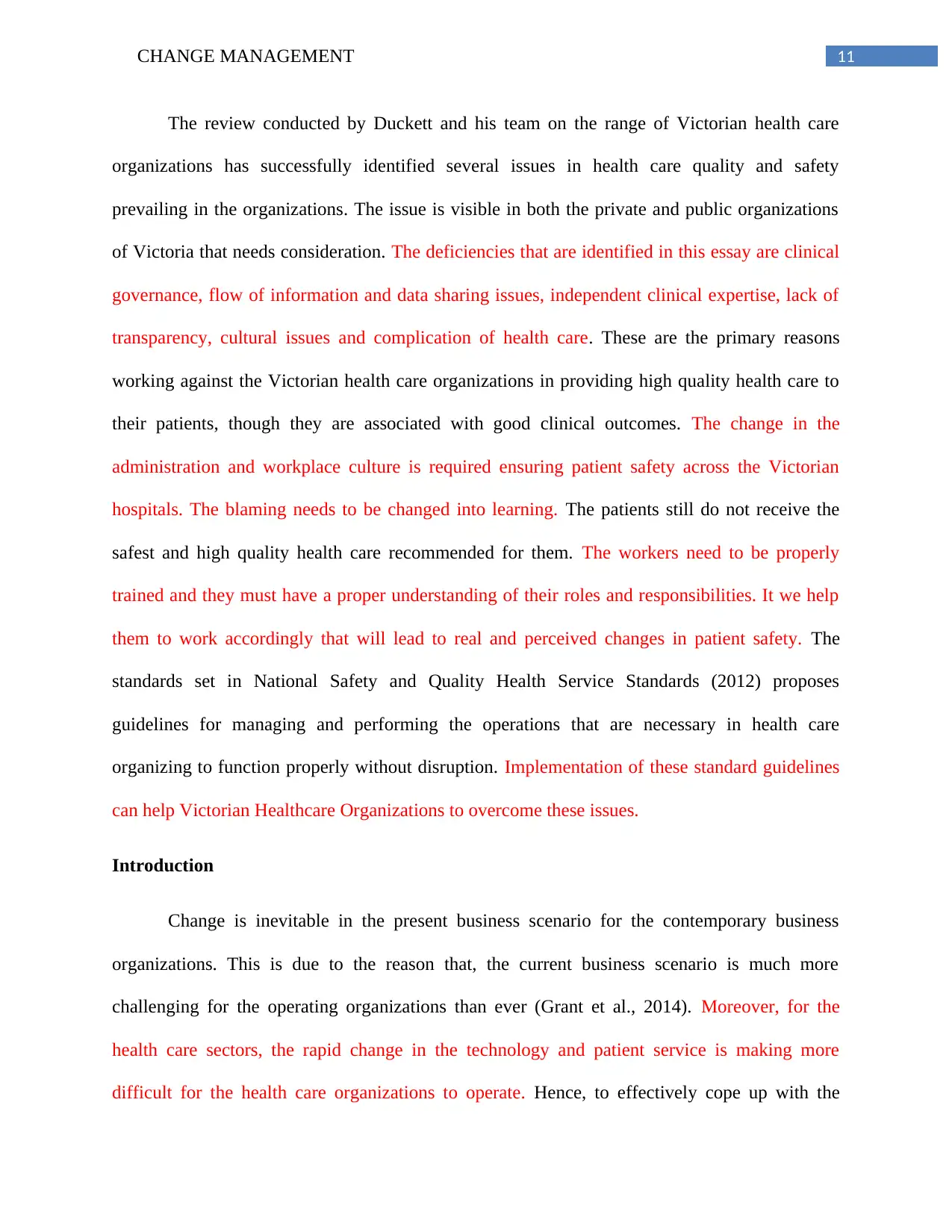
11CHANGE MANAGEMENT
The review conducted by Duckett and his team on the range of Victorian health care
organizations has successfully identified several issues in health care quality and safety
prevailing in the organizations. The issue is visible in both the private and public organizations
of Victoria that needs consideration. The deficiencies that are identified in this essay are clinical
governance, flow of information and data sharing issues, independent clinical expertise, lack of
transparency, cultural issues and complication of health care. These are the primary reasons
working against the Victorian health care organizations in providing high quality health care to
their patients, though they are associated with good clinical outcomes. The change in the
administration and workplace culture is required ensuring patient safety across the Victorian
hospitals. The blaming needs to be changed into learning. The patients still do not receive the
safest and high quality health care recommended for them. The workers need to be properly
trained and they must have a proper understanding of their roles and responsibilities. It we help
them to work accordingly that will lead to real and perceived changes in patient safety. The
standards set in National Safety and Quality Health Service Standards (2012) proposes
guidelines for managing and performing the operations that are necessary in health care
organizing to function properly without disruption. Implementation of these standard guidelines
can help Victorian Healthcare Organizations to overcome these issues.
Introduction
Change is inevitable in the present business scenario for the contemporary business
organizations. This is due to the reason that, the current business scenario is much more
challenging for the operating organizations than ever (Grant et al., 2014). Moreover, for the
health care sectors, the rapid change in the technology and patient service is making more
difficult for the health care organizations to operate. Hence, to effectively cope up with the
The review conducted by Duckett and his team on the range of Victorian health care
organizations has successfully identified several issues in health care quality and safety
prevailing in the organizations. The issue is visible in both the private and public organizations
of Victoria that needs consideration. The deficiencies that are identified in this essay are clinical
governance, flow of information and data sharing issues, independent clinical expertise, lack of
transparency, cultural issues and complication of health care. These are the primary reasons
working against the Victorian health care organizations in providing high quality health care to
their patients, though they are associated with good clinical outcomes. The change in the
administration and workplace culture is required ensuring patient safety across the Victorian
hospitals. The blaming needs to be changed into learning. The patients still do not receive the
safest and high quality health care recommended for them. The workers need to be properly
trained and they must have a proper understanding of their roles and responsibilities. It we help
them to work accordingly that will lead to real and perceived changes in patient safety. The
standards set in National Safety and Quality Health Service Standards (2012) proposes
guidelines for managing and performing the operations that are necessary in health care
organizing to function properly without disruption. Implementation of these standard guidelines
can help Victorian Healthcare Organizations to overcome these issues.
Introduction
Change is inevitable in the present business scenario for the contemporary business
organizations. This is due to the reason that, the current business scenario is much more
challenging for the operating organizations than ever (Grant et al., 2014). Moreover, for the
health care sectors, the rapid change in the technology and patient service is making more
difficult for the health care organizations to operate. Hence, to effectively cope up with the
⊘ This is a preview!⊘
Do you want full access?
Subscribe today to unlock all pages.

Trusted by 1+ million students worldwide
1 out of 28
Related Documents
Your All-in-One AI-Powered Toolkit for Academic Success.
+13062052269
info@desklib.com
Available 24*7 on WhatsApp / Email
![[object Object]](/_next/static/media/star-bottom.7253800d.svg)
Unlock your academic potential
Copyright © 2020–2025 A2Z Services. All Rights Reserved. Developed and managed by ZUCOL.





